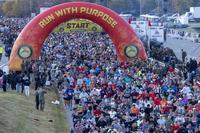There are many opinions about what the perfect workout might be. Of course, whether it is perfect, depends on the opinion of the person doing it. I believe the perfect workout is the one that gets done and is consistently enjoyed by the person who's doing it.
However, there are more scientific definitions that a goal-oriented person can consider. Here are some truths to consider when creating workouts for yourself.
Warmups
Any workout worth its weight must have some form of a warmup. Whether it is easy cardio, low-repetition calisthenics, dynamic stretches or light weightlifting movements, at least one of these activities is needed to get the body warmed up.
You need to increase the blood flowing through the muscles that are about to get worked and increase your heart rate and body temperature to get a proper warmup. You cannot have a perfect workout without a warmup of some kind.
Most Important Event Comes First
If you want to improve your strength, consider placing your heavier compound movements at the beginning of the workout. High-repetition calisthenics or heavy weight training events need to be at the front of the workout if the main goal is to improve these events (strength or muscle stamina).
However, if the goal is to improve upon running or swimming times, you should do the cardio events first. It is difficult to improve on strength and cardio simultaneously.
Consider doing a cycle of the area needing the most improvement first, then follow with the secondary event as more of a maintenance exercise, especially if you are training for any of the tactical professions where being good at both strength and endurance are a requirement. This approach lets you focus on the weakness first while also maintaining your best events.
Secondary Events Can Follow
Easier lifting exercises like isolation movements that use lighter weights and involve a simple movement with one or two joints can be done after the more difficult compound movements are completed (squats, deadlifts, power cleans, etc.).
However, on cardio and running days when you add in faster-paced running (sprints or faster than timed pace), you may want to wait until you are thoroughly warmed up and ready to push speed to near max levels. Pulled hamstrings and injuries to hip muscles and Achilles' tendons are common when running faster or jumping on legs that you have not progressively prepared.
Cardio and Cooldown
If your workout was focused on strength training, finishing the workout with a cardio session will help you stay in better condition and burn more calories. Working on timed running or swimming events is a good way to do that.
If your workout of the day was a cardio conditioning base, consider making this section more of a cardio cooldown with an easier version of cardio than the earlier part of your workout. Personally, I think a non-impact cardio event like swimming or biking is a great cardio option and cooldown option regardless of the workout focus.
Mini-Mobility and Stretch Session
One of the recommendations I make to the folks who train with me is to finish the workout with five minutes of easy cardio (walk, bike, row, elliptical, treading water, etc.), followed by five minutes of static stretching. If you feel like you need more of a cooldown session, repeat the five-minute cardio and five-minute stretching and/or foam rolling by massaging muscles and joints one more time.
Next time you train, consider the model above to help you structure what could very well become a perfect workout method for you. To really classify what you are doing into the "perfect" category, you have to be consistent with it, so keep moving.
Stew Smith is a former Navy SEAL and fitness author certified as a Strength and Conditioning Specialist (CSCS) with the National Strength and Conditioning Association. Visit his Fitness eBook store if you're looking to start a workout program to create a healthy lifestyle. Send your fitness questions to stew@stewsmith.com.
Want to Learn More About Military Life?
Whether you're thinking of joining the military, looking for fitness and basic training tips, or keeping up with military life and benefits, Military.com has you covered. Subscribe to Military.com to have military news, updates and resources delivered directly to your inbox.



















